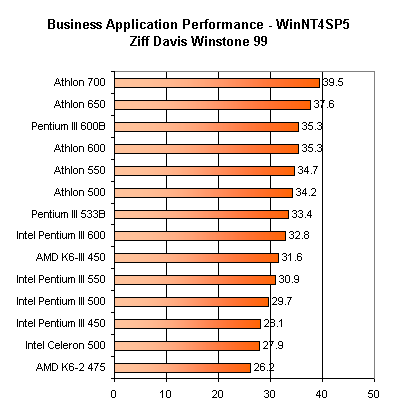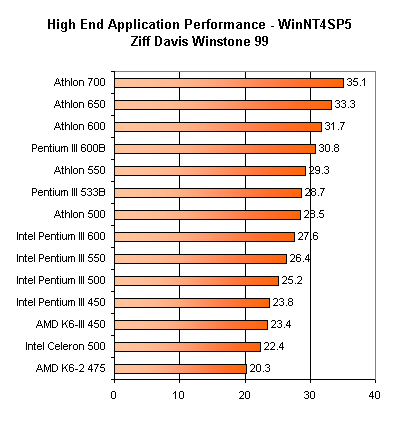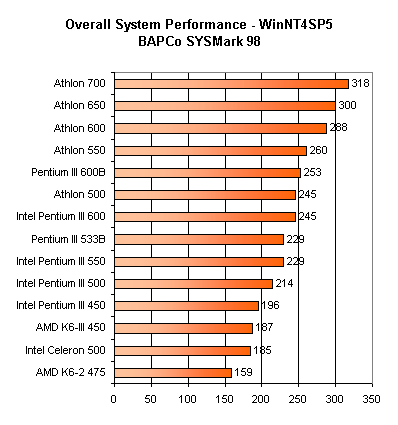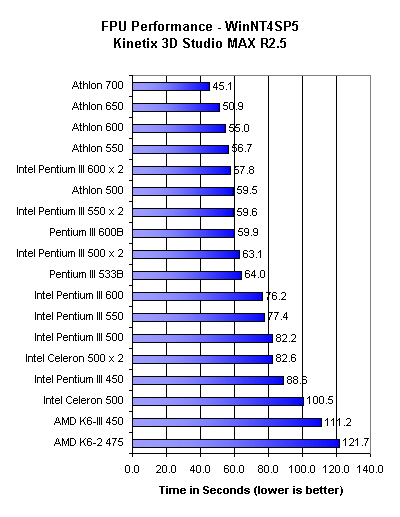
Original Link: https://www.anandtech.com/show/386
 There's nothing wrong with being slack. Some
call it lazy, others may criticize it, but as long as it only affects a single person,
there is nothing wrong with being slack. It's a person's choice whether or not they want
to be slack, and truthfully, we are all slack at one point in our lives, it's healthy. But
what happens when a company is slack?
There's nothing wrong with being slack. Some
call it lazy, others may criticize it, but as long as it only affects a single person,
there is nothing wrong with being slack. It's a person's choice whether or not they want
to be slack, and truthfully, we are all slack at one point in our lives, it's healthy. But
what happens when a company is slack?
Since February 1999 Intel has released a total of four Pentium III processors, the 450, 500, 550, and 600, none of which have offered considerable performance improvements over the previous generation of CPUs for most enthusiasts. For this reason, most enthusiasts that are budget conscious are still running their old Pentium IIs or Celerons since there isn't an important reason to upgrade. What separates a Pentium III from a Pentium II is very little, nothing that would make a user wake up and say "I need a Pentium III." In summary, Intel has been very slack.
From the standpoint of competition, they have had every right to be because, AMD has previously only been around to compete with Intel on the low-end. Intel didn't have to worry about AMD's K6-III intruding on their share of the server market, they didn't have to worry about the K6-2 stealing the territory of their Dual Pentium III systems in the 3D modeling/rendering arena, and they had no fear that AMD would be competing with them on a clock for clock basis anytime soon.
If left unchecked, a company will continue to adhere to a roadmap that doesn't offer any groundbreaking achievements unless there is a demand for one. AMD saw this opportunity and is taking advantage of it for as long as they can. Since the release of the Athlon in August 1999, AMD has already announced 5 clock speeds, the fifth coming on the publication of this review. Intel never had to worry about AMD competing on a clock for clock basis before but, the tables have turned, and AMD is the first desktop CPU manufacturer to publicly hit 700MHz and they're doing it with style.
Welcome to the world of the Athlon 700.
Good Yields Mean Higher Clock Speeds
The yields on the Athlon (the percentage of usable/marketable CPUs out of the number of CPUs produced) have been incredible. Since before the release of the K5, the Athlon is the highest yielding CPU AMD has produced for public release. Athlon systems are appearing on store shelves and they aren't costing a fortune either. A fully fledged Compaq system based on the Athlon 600 is retailing for around $1500, and considering that the CPU can easily outperform anything on Intel's side of the field, that price isn't bad at all.
The 650MHz Athlon parts are slowly but surely filtering down into the hands of the public as well. Not only does the 22 million transistor CPU have no problem hitting the 650MHz mark, a clock speed higher than the fastest Intel CPU currently available at the time of publication, it is already at the amazing 700MHz point and climbing. All of this on a 0.25-micron fabrication process that is just beginning to show the signs of reaching its limits, the Athlon has some room to grow.
AMD had originally not planned to release the 700MHz Athlon this early in the product release, but with the good yields on the Athlon, it seems as if the 700 and 750MHz marks are not impossible targets at all. This is very good news for AMD and bad news for Intel, who is in the middle of a die shrink down to 0.18-micron in order to compete with the clock speeds already offered by the Athlon.
The Basics
For a description of how the Athlon works and all of the technology that goes into the Athlon, take a look at our AMD Athlon review.
The 700MHz part hasn't changed from the other four clock speeds currently available. The CPU operates at a 1.6v core voltage, makes use of a 7.0x-clock multiplier, and a 100MHz FSB that transfers on both the rising and falling edges of the clock (this produces the equivalent of the 200MHz FSB that the EV6 protocol ambiguously specifies).
The Athlon 700 naturally draws more current than the previous speeds and some early boards may have difficulties supplying the processor with the right amount of current. But, rest assured that once the CPU begins shipping in quantities to the public there will be motherboards that are more than capable of driving it. November will be a good month for Athlon motherboards…
Other than that, the CPU is completely unchanged from the Athlon that debuted just under 2 months ago. Below you'll find a quick specifications chart to compare the Athlon to previous and upcoming CPUs:
Intel |
AMD |
|||||
| Celeron | Coppermine | Pentium III | K6-2 | K6-III | Athlon | |
| Transistors | 19 million | approx. 27 million | 9.5 million | 8.8 million | 21.3 million | 22 million |
| Core Voltage | 2.0v | Not Announced | 2.0v | 2.2v/2.4v | 2.4v | 1.6v |
| MB Interface | Slot-1/Socket-370 | Slot-1/Socket-370 | Slot-1 | Socket-7 | Socket-7 | Slot-A |
| L1 Cache | 16KB Data 16KB Instruction Set |
Not Announced | 16KB Data 16KB Instruction Set |
32KB Data 32KB Instruction Set |
32KB Data 32KB Instruction Set |
64KB Data 64KB Instruction Set |
| L2 Cache | 128KB | 256KB | 512KB | 0KB | 256KB | 512KB |
| L2 Cache Speed | CPU Clock Speed | CPU Clock Speed | 1/2 CPU Clock Speed | FSB | CPU Clock Speed | 1/2 CPU Clock Speed |
| Available Clock Speeds | 300MHz - 500MHz | 600MHz+ | 450MHz - 600MHz | 300MHz - 500MHz | 400MHz - 500MHz | 500MHz - 700MHz |
There are some very interesting things to look forward to by the end of this year. There is no doubt about it that the Athlon has definitely won this battle between AMD and Intel. The Pentium III is simply no match for the Athlon in terms of performance. But what do we have to look forward to from Intel?
The Coppermine should have some very unique offers to make that will give the Athlon some healthy competition. The transistor count of the Coppermine is one thing that you shouldn't get too excited about. Like the Celeron with its 128KB L2, the Coppermine has to account for a full 256KB of L2 cache on its die, thus contributing to that ~27 million transistor count.
From AMD's side of the game, the Athlon is just getting started. The transition to a 0.18-micron fabrication process should pave the way for the 1GHz+ Athlon CPUs and if they make the transition to 0.18-micron as smoothly as they've been boasting they can then the Athlon can become an even more powerful force into the year 2000.
But for now, we're "stuck" at the 700MHz frequency of AMD's latest release. So let's get on to the test...
The Test
Click
here for detailed descriptions of all of the tests run.
Click
Here for a detailed description of the four visual test modes used in the Quake 3
tests.
Windows 98 SE Test System |
|||||
Hardware |
|||||
CPU(s) |
Intel Pentium III 600B |
Intel Pentium III 600 Intel Pentium III 550 Intel Pentium III 500 Intel Pentium III 450 |
Intel Celeron 500 | AMD K6-III 450 AMD K6-2 475 |
AMD Athlon 700 AMD Athlon 650 AMD Athlon 600 AMD Athlon 550 AMD Athlon 500 |
| Motherboard(s) | AOpen AX6C | ABIT BX6 R2 | ABIT BX6 R2 + "Sloket" Adapter | Tyan Trinity S1598 | FIC SD11 |
| Memory | 128MB Samsung PC800 RDRAM |
128MB PC133 Corsair SDRAM |
|||
| Hard Drive | IBM Deskstar 22GXP 22GB Ultra ATA 66 HDD |
||||
| CDROM | Phillips 48X |
||||
| Disk Controller | Promise Ultra 66 - Ultra ATA 66 Controller |
||||
| Video Card | Diamond Viper V770 Ultra clocked at 150/183MHz (core/mem) |
||||
| Ethernet | Linksys LNE100TX 100Mbit PCI Ethernet Adapter |
||||
Software |
|||||
Operating System |
Windows 98 SE |
||||
| Video Drivers | NVIDIA Reference Detonator 2.08 drivers |
||||
Benchmarking Applications |
|||||
Business |
Ziff Davis Winstone 99 |
||||
| Gaming | idSoftware Quake 3 Test 1.08 (OpenGL) |
||||
Windows 98 SE Test System |
|||||
Hardware |
|||||
CPU(s) |
Intel Pentium III 600B |
Intel Pentium III 600 Intel Pentium III 550 Intel Pentium III 500 Intel Pentium III 450 |
Intel Celeron 500 | AMD K6-III 450 AMD K6-2 475 |
AMD Athlon 700 AMD Athlon 650 AMD Athlon 600 AMD Athlon 550 AMD Athlon 500 |
| Motherboard(s) | AOpen AX6C | Soyo SY-D6IBA2 | Soyo SY-D6IBA2 + "Sloket" Adapter | Tyan Trinity S1598 | AMD Fester Motherboard |
| Memory | 128MB Samsung PC800 RDRAM |
128MB PC133 Corsair SDRAM |
|||
| Hard Drive | IBM Deskstar 22GXP 22GB Ultra ATA 66 HDD |
||||
| CDROM | Phillips 48X |
||||
| Disk Controller | Promise Ultra 66 - Ultra ATA 66 Controller |
||||
| Video Card | Diamond Viper V770 Ultra clocked at 150/183MHz (core/mem) |
||||
| Ethernet | Linksys LNE100TX 100Mbit PCI Ethernet Adapter |
||||
Software |
|||||
Operating System |
Windows NT 4 + Service Pack 5 |
||||
| Video Drivers | NVIDIA Reference Detonator 2.08 drivers |
||||
Benchmarking Applications |
|||||
Business |
Ziff Davis Winstone 99 |
||||
| Professional | Kinetix 3D Studio MAX R2.5 |
||||

Every processor on this chart is more than capable of dealing with your most "intense" business applications, there is no point in going after a 700MHz anything to run MS Word.

BAPCo's SYSMark provides a much better picture of the overall performance of the CPUs. The 700MHz Athlon offers a 24% performance advantage above Intel's fastest contribution on the chart. But if you're only looking to beat Intel's fastest, then AMD's second "slowest" Athlon at 550MHz does the job quite well.
It'll be interesting to see how well the Coppermine stands up in this test, but if the architecture stays the same it is highly unlikely that even a 700MHz Coppermine will blow the Athlon out of the water here.

We're still getting used to seeing AMD at the top of a gaming performance chart, but the engineers at AMD are surely loving it. Nothing but domination from AMD, even their "slowest" Athlon comes in ahead of Intel's Pentium III 600B. While the lead is hardly noticeable, what is noticeable is that the Athlon 500 retails for considerably less than Intel Pentium III 600B.

Quake 3 tells a familiar story as well.

AMD's performance advantage under Expendable has always been much less than what Quake has given us simply because of the design of the game. This just goes to show you that the Athlon isn't the "20% faster than Intel" killer that some benchmarks will make it out to be. It is a fast CPU, but at equivalent clock speeds, this is one test where Intel could compete quite nicely.

The advantage is restored once again in the Half Life benchmark. What good is a benchmark of a game using a modified Quake 2 engine? Although Quake 3 is stealing the lime light games like Soldier of Fortune have yet to come out and are still based on heavily modified versions of the Quake 2 engine.

Windows NT: the future of Operating Systems? That's a completely different question, but what we can see here is that the Intel/AMD competition is much more heated under NT. The clear winner is the Athlon 700, as you would expect, but with a tie between the Pentium III 600B and the Athlon 600, Windows NT is a much more interesting arena to benchmark in.

The stronger FPU of the Athlon keeps the top three positions reserved to AMD but the Pentium III 600B is on the heels of the Athlon 600. Remember, Intel doesn't have the weakest FPU, it's just not as strong as the Athlon's. That doesn't mean that it won't remain competitive.

Even under NT, the overall performance of the Athlon is still greater than that of Intel's fastest. It'll take quite a bit to match the power of the Athlon 700.

In 3D Studio MAX the Athlon 700 has no immediate danger from any competition since the fastest Intel CPU is only on the heels of the Athlon 500. It'll be interesting to see what a Dual Athlon setup would be able to accomplish here, as well as what a dual i820 board running a pair of Coppermines is capable of doing.
Conclusion
What did we expect from the Athlon 700? Everything we got from the Athlon 700. The CPU is just a faster Athlon, which is definitely good for AMD for the time being, but what will it do in the long term?
Nothing much if Intel releases a drastically different architecture with their upcoming Coppermine CPU that completely blows the Athlon away. But chances are that this won't be the case, and the Coppermine won't be anything more than the same Pentium III core that we're used to with 256KB on-die L2 cache running at clock speed.
What the Athlon 700 does is it puts another step between Intel's fastest and AMD's fastest which is very good for the company. But what it doesn't do is secure the performance title for AMD throughout the rest of the year and on into 2000. Intel's Pentium III B doesn't do much with the i820 and RDRAM under Windows 98. But under NT, and especially under high bandwidth applications such as 3D Studio MAX where a lot of data is being manipulated, the 133MHz FSB + RDRAM makes for a very competitive combo. The Coppermine may push that competitive barrier even further, and may begin to threaten AMD's territory there.
So what does AMD have planned? The Athlon is definitely going to hit 750MHz shortly, the rumors are all in place and the yields are there for AMD to hit that magical 750, but will they or will you do it first? We all know that it is possible to overclock the Athlon, and it's just a matter of time before the motherboards with overclockable FSB settings begin getting into the hands of Athlon owners.
The FIC SD11 already offers 120 and 133MHz FSB settings (x 2 = 240/266MHz) and there are quite a few motherboards in the works that offer FSB settings up to 150MHz in smaller increments. Armed with an Athlon 700 and some good cooling, you better believe that the overclockers will be the first to hit 750MHz.
Intel knows what the Athlon architecture can do, and the only thing AMD can do right now is make the Athlon faster. So unless the Coppermine comes out on top with a superior architecture than the Athlon, it'll be highly unlikely that you'll see Intel back on top until the release of their next big thing.
The good news is that a 700MHz Athlon drives the prices of the 650, 600, 550, and 500MHz Athlons down. It also puts the pressure on Intel to compete so they'll lower their prices and work on cranking out similarly performing products. So even if you're not in the market for the 700MHz wonder, you'll be affected by its release. Isn't competition grand?
Now if we could only get some good motherboards...don't worry, November will hold some wonderful surprises...we hope ;)







